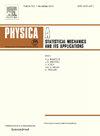利用微观模拟模型研究高速公路匝道瓶颈附近的混合交通特征
IF 3.1
3区 物理与天体物理
Q2 PHYSICS, MULTIDISCIPLINARY
Physica A: Statistical Mechanics and its Applications
Pub Date : 2024-10-03
DOI:10.1016/j.physa.2024.130134
引用次数: 0
摘要
在早期的混合交通环境中,出于交通安全和稳定性的考虑,联网和自动驾驶车辆(CAV)倾向于遵循简单的控制规则。综合分析高速公路匝道瓶颈周围混合交通的整体表现和车与车之间的相互作用,是进一步进行交通管理和控制的基础。然而,现有研究中的 CAV 主要以合作车辆排的形式出现,仿真软件中的混合交通场景并不适用于深入研究。本文旨在开发一种微观仿真模型,详细研究高速公路匝道周边基于车道的混合交通性能。该模型首先通过结合不同的微观交通模型,考虑了单个人类车辆(HV)和 CAV 的车辆特性。在构建了假设的匝道瓶颈结构后,在不同的交通流量和不断变化的 CAV 市场渗透率(MPRs)条件下开发了各种模拟场景。模拟结果表明,混合交通流在拥堵模式和交通容量方面都得到了改善。对于振荡和近乎均匀的拥堵交通,当 CAV MPR 分别超过 30% 和 50% 时,拥堵程度会大大降低。当为 CAV 设定的期望时间间隙较小时,混合交通容量增加了 19.3%,而当设定的期望时间间隙较大时,混合交通容量则没有明显变化。在 HV-HV 的相互作用中,交通冲突受到 CAV 的轻微影响。相对而言,HV-CAV 相互作用中的冲突情况更严重,碰撞时间(TTC)大于 2 秒的比例随着 CAV MPR 的增加而单调下降。结论是,当 CAV 的 MPR 和混合交通中 CAV 所需的时间间隙合适时,交通特征总体上呈现出良好的势头。本文章由计算机程序翻译,如有差异,请以英文原文为准。
Study on mixed traffic characteristics around highway on-ramp bottleneck using a microscopic simulation model
In the early mixed traffic environment, connected and automated vehicles (CAVs) tend to follow simple control rules for the sake of traffic safety and stability. Comprehensive analysis of overall mixed traffic performance and vehicle to vehicle interactions around highway on-ramp bottleneck is a basis for further traffic management and control. And yet CAVs in existing researches are mainly in the form of cooperative vehicular platoon, and mixed traffic scenarios within simulation software are not applicable for in-depth investigation. The purpose of this paper is to develop a microscopic simulation model to study in detail lane-based mixed traffic performance around the highway on-ramp. This model firstly considers vehicle characteristics of individual human vehicles (HVs) and CAVs by combining different microscopic traffic models. After the hypothetical on-ramp bottleneck structure is constructed, various simulation scenarios are developed under varying traffic volumes and changing market penetration rates (MPRs) of CAVs. Simulation results show that mixed traffic flow is improved in terms of congestion patterns and traffic capacity. For oscillating and nearly homogeneous congested traffic, congestion degrees are greatly reduced when CAV MPR above 30 % and 50 % respectively. Mixed traffic capacity is increased by 19.3 % when a smaller desired time gap set for CAVs, while it shows no significant change in a larger value. In the HV-HV interactions, traffic conflicts are slightly influenced by CAVs. Comparatively, conflict situations in HV-CAV interactions get worse, the proportion of time to collision (TTC) greater than 2 s monotonically declining with the rise in CAV MPR. It is concluded that traffic characteristics overall show a good momentum when MPR of CAV and the desired time gap of CAVs in mixed traffic are appropriate.
求助全文
通过发布文献求助,成功后即可免费获取论文全文。
去求助
来源期刊
CiteScore
7.20
自引率
9.10%
发文量
852
审稿时长
6.6 months
期刊介绍:
Physica A: Statistical Mechanics and its Applications
Recognized by the European Physical Society
Physica A publishes research in the field of statistical mechanics and its applications.
Statistical mechanics sets out to explain the behaviour of macroscopic systems by studying the statistical properties of their microscopic constituents.
Applications of the techniques of statistical mechanics are widespread, and include: applications to physical systems such as solids, liquids and gases; applications to chemical and biological systems (colloids, interfaces, complex fluids, polymers and biopolymers, cell physics); and other interdisciplinary applications to for instance biological, economical and sociological systems.

 求助内容:
求助内容: 应助结果提醒方式:
应助结果提醒方式:


